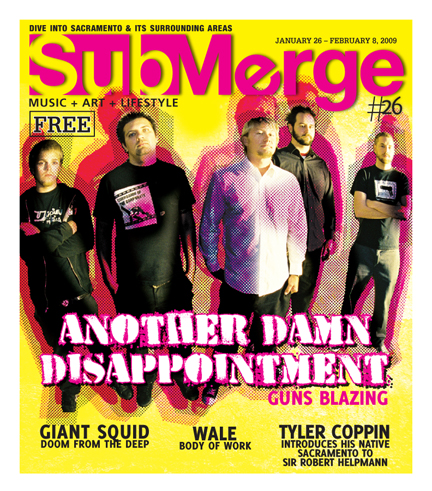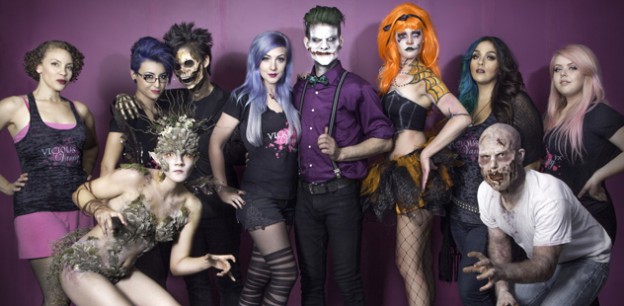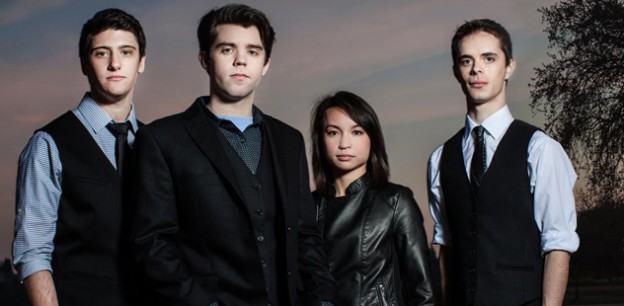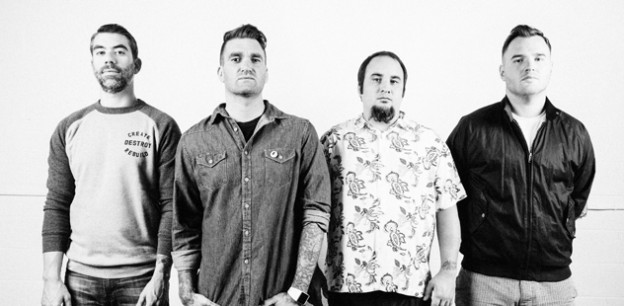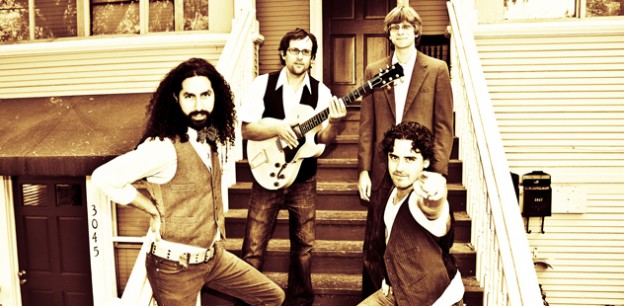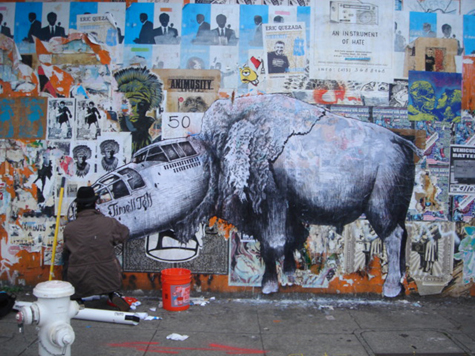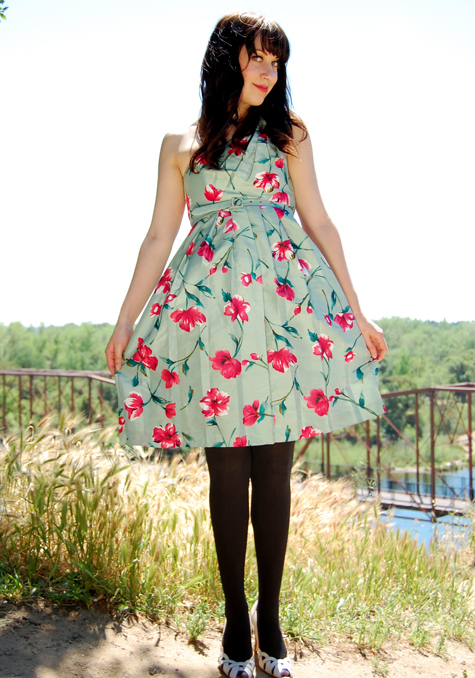Pictured from left to right Vicious Vanity FX team: Sara Logan, Nina Zepeda, Nicole Chilelli, Eva Lamorte, Britta Jones. Models left to right: Victoria Timoteo, Brendon, Cody LaCrue, Kelli Knudson, Casey Montgomery
The Halloween Professionals
In a small shop in Roseville, nestled between a gas station and a cluster of small businesses, Halloween has already started. Nicole Chilelli, a beauty and special effects makeup artist and the owner of Vicious Vanity FX, oversees two of the artists from her shop as they spend Saturday evening crafting a costume for a character called The Root of Evil.
“She is this character that came out of the Sleepy Hollow tree,” explains Chilelli. “She’s the reason why that tree is so evil. And this tree kind of just sucked her up and engulfed her with evilness. The Headless Horseman, that’s like her minion that she sends out to do her dirty work, and the more people it kills, the more the roots grow on her body, which gives her more strength … That’s why she’s the root of all evil.”
This costume is being prepared for an upcoming class being taught by Chilelli at the Sacramento horror convention Sinister Creature Con. During the class, participants will be able to see each step that goes into creating this costume. Chilelli describes the Root of Evil character as “fantasy and horror mixed together with beauty.” On day two of the convention, Chilelli will be demonstrating the creation of a Botanical Alien Hybrid, another original character.
“He’s inspired by this plant I saw when I was in Costa Rica,” she explains. “This crazy leaf that pods up and then it opens into this heart that has black spots all in the inside. It’s like an alien.”

{Cyborg Alien: model Cody LaCrue | Photo by Dan Herrera}
Throughout the shop, artists are working on bits and pieces from different costumes and half-finished projects. Chilelli and her team make every part of the costumes here, down to the molds. “We’ve got some Maleficent horns over there, we’ve got wounds and zombies and creatures and a fawn, fairy ears, pretty much anything you can think of,” she says. They sculpt and hand-paint all their prosthetics, resulting in prosthetics that blend right in with the skin. Chilelli explains that most mass-produced prosthetics have huge edges that prevent them from looking realistic.
“I think it kind of kills your confidence as a makeup artist when you go, ’I just got this really nice expensive prosthetic and I can’t make it blend in,’” she says. “So I’m trying to do stuff that is hand done and has more care put into it so that the everyday artist can apply this and feel like they accomplished something.”

{Work from Face Off Season 3 | Photo by Brett-Patrick Jenkins }
Starting this business was a natural fit for Chilelli, who considered herself an artist from the time she could hold a pencil and always loved drawing, painting and sculpting. She’s also loved Halloween since she was small. She and her dad spent every Halloween setting up their yard to scare all of the little kids who came by.
Chilelli first recognized that this could be part of a future career one particular Halloween, after she had spent four hours painting a dead foot that she had placed hanging out of the trunk of her car.
“I was out in the sun, and I hate the sun—everyone knows that I’m like a vampire. I was out there in the sun for four hours painting this hand,” she remembers.
Her dad came out and asked if she was OK, and then said to her, “Think about it though—this is movie makeup. This is what you should be doing.”
And special effects makeup indeed was a blend of all her different interests—art, Halloween, fantasy and beauty. Makeup became her outlet as an artist.
“The first time I think I really made a full character and it was done, I pulled my brush back and looked and he opened his eyes I was like, ‘You’re like a person! You’re alive! My character is alive!’” remembers Chilelli. “It’s like Frankenstein. It’s such a cool feeling.”
With a couple community college courses to learn the basics, a stack of books and a lot of trial and error, Nicole was on her way to becoming a self-taught special effects makeup artist. “It was before the age of lovely YouTube where you can just see how everything is done, so I kind of had to just trial and error,” she says.
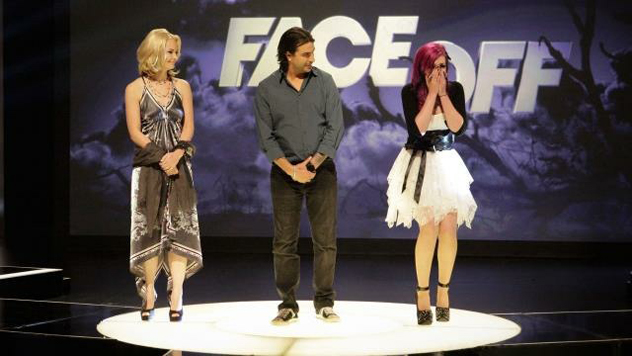
{Nicole Chilelli (far right) after they announced her the winner of Face Off Season 3}
Chilelli’s pivotal career moment was winning the reality TV show competition on the Syfy channel called Face Off, which pits a group of prosthetic makeup artists against each other to create science fiction and horror characters. Chilelli remembers being surprised when she made the audition and got on the show—she hadn’t had any formal training and really didn’t think she was ready for it.
“The first few episodes I really was more into trying to impress and over-show my work,” she says. “I feel like when you do too much to show off you end up losing the overall idea and the overall character.”
At one point she even got voted off the show, but ended up making it back on, and from that point she changed her approach. Instead of working to impress others, she made the characters she herself would be excited to see on the stage, and she started winning. “It’s such an awe-inspiring moment to know that just staying true to your art and doing you can take you that far,” she says.
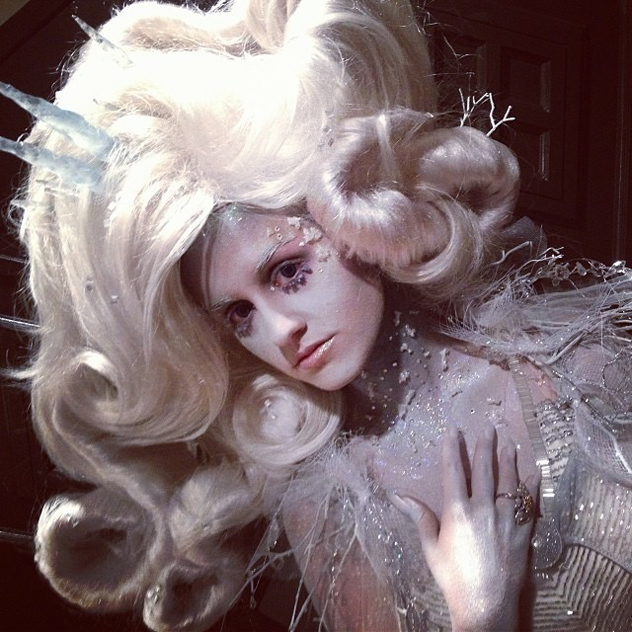
{Ice queen makeup done for E! Hollywood red carpet show for the Oscars | Photo and makeup by Nicole Chilelli}
Chilelli started her business about a year later, initially from her kitchen. She remembers having nowhere to hang her clothes because her closets were full of materials. The business expanded into the garage next, and then into the shop, and took off from there. “We’ve got all kinds of materials that I never thought I would have” she says. “We have all the resources that you can think of.”
The team at Vicious Vanity FX is busy year-round, not just during Halloween. They work on films and photoshoots, both with local groups and beyond. Weddings, proms and other special events are all within their repertoire. “A lot of people think that we’re just effects artists, but we have the skillsets to do all of it,” says Chilelli. “Effects is a lot harder than beauty. We can do beauty.”
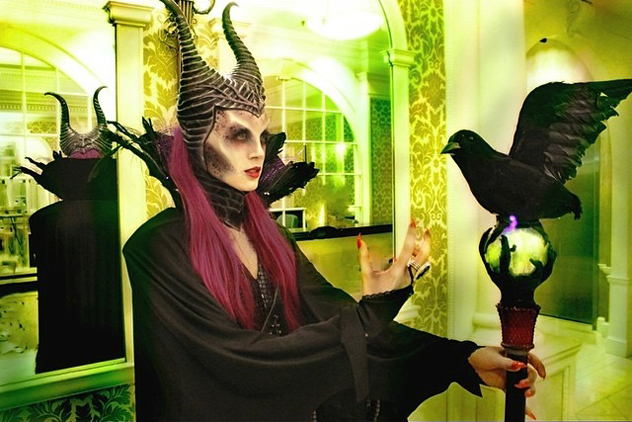
{Malefacent makeup, model Aja U | Photo and makeup by Nicole Chilelli}
The team at Vicious Vanity FX will be bringing their art to the public this year by opening their studio for Halloween appointments. Chilelli says that in addition to their pre-created costumes, they can work with people to create “pretty much anything someone can think of.” To get started, the team needs a list of all the items that the person needs help with, and from there they will provide a quote for each piece. They can also help people who aren’t sure what costume they would like to choose. There will be about six artists working at once, allowing them to cover as many people as possible during crunch time.
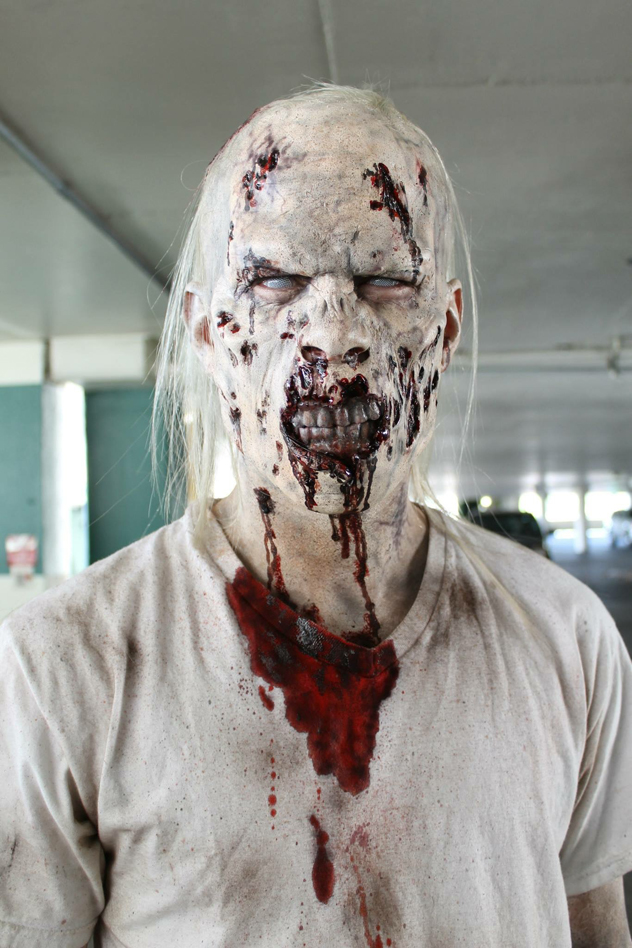
{Rotting Zombie: model Cody LaCrue | Photo and makeup by Nicole Chilelli}
Opening up the shop for individual appointments is a big deal, not only because it’s their first Halloween doing this, but because until now the shop has been completely closed to the public, with all their business taking place online. Chilelli says that after spending the past few Halloweens working as makeup artists for a haunted house, she and her team are excited to be branching out and doing something new.
“I feel like we really could offer a lot to the community and just get out there and have fun with people, so we’re excited,” she says. “We’re really bringing movie-quality stuff to everyone this Halloween.”
Nicole Chilelli will be teaching two classes at Sinister Creature Con, Oct. 17 and Oct. 18, 2015, at the Scottish Rite Center located at 6151 H St., Sacramento. Sign up online at Viciousvanityfx.com/shop. To make a Halloween appointment, visit Viciousvanityfx.com or email ViciousVanityFx@yahoo.com.
Sounds and Pictures
It’s hard to beat the energy of a live show played by enthusiastic young musicians, especially when they’re rocking out to universally loved jams from the ‘50s and ‘60s. Todd Morgan and the Emblems originally formed as a ‘50s cover band—a tribute to the great rock ‘n’ roll legends that had a lasting influence on lead singer/songwriter Todd Morgan. While their sound has evolved from those early days into more modern rock, the band’s energy hasn’t diminished.
Todd Morgan and the Emblems is, at its heart, a group of early-20s musicians who appreciate good, old-fashioned rock ‘n’ roll. Today, the band members are Todd Morgan (vocals/piano/guitar), Patrick Owen (guitar), Jessica Luna (bass) and Cameron Womack (drums). But as so many band stories start, Todd Morgan and the Emblems was formed with a different lineup and a different sound. As a junior in high school, Morgan put together a band that would play a combination of ‘50s cover songs and some of Morgan’s original songs. They recorded their first album in 2009.
From there, the music went through a transition. Old-time music would always be an influence, but Morgan decided he wanted to write something more modern. The band released its second album, Reality, in 2012, which Todd says was the debut album for their current style and sound. The band still plays ‘50s and ‘60s at live shows, and there’s no denying the influence of that era on their current sound, but it’s all modern rock now.
The sound of Todd Morgan and the Emblems is hard to characterize by a particular genre or sound, although “rock” is an obvious label. “I write catchy pop things … It’s basically pop music in the same vein as the Beatles were pop music, or Elton John, or Michael Jackson,” Morgan says. “It’s pop music but I try to put something there that’s not just catchy because it’s repetitive but catchy because the melody makes it catchy.”
The band doesn’t try to hit a particular demographic or audience with their music—they go for what they think the greatest capacity of people will gravitate toward. “Not in a milquetoast kind of way, but actually make something that tries to be as good as possible so it brings people to the same table,” he says. “I want everybody to dig it.”
While always interested in music itself, Morgan’s interest in becoming a musician didn’t start until high school, when he started attending Rio Americano High School and getting involved with the band program. He remembers it being very dismal at first—the school is known for its band program, and he felt he was in way over his head. “I could play in one key and keep time,” he says.
The day he remembers best was the day they held auditions to see what band each person would be in. They put Morgan into the back room to practice. “It felt like a put-down,” he says. But he worked on learning the new tunes and chords he was instructed to.
“I’m glad that approach was taken. It made me realize these are things you have to know to fit in with other musicians,” he says. Now, he feels confident he can go into any city, any club, and find common songs so that he can jam with other musicians.
The competition introduced through his high school band program had a lasting effect on Morgan.
“Musicians at that age are pretty cocky. They will laugh at you and put you down the second you make mistakes. But a lot of them are really good musicians so you can learn from them,” he says.
Morgan admits he’s always been competitive, and the fear of falling behind drove him to work harder and practice more. By the time he was ready to put together his own band, he was primed to practice five hours a day or more and make a solid effort at a career as a musician.
Today, music is Morgan’s full-time job, and he’s not afraid to put in the work required to create something that is good on a very real level, not just something that people will like. He is very interested in the production element of the music he creates as well—probably more than many artists.
“Anything I’m involved in that my name is going on, I want to know what was used in it,” he says. To him, the technical is part of the music. “The tone or the way it’s edited … it’s all part of what ends up being the performance.”
Morgan was particularly involved in the production of the band’s “Crazy Cryin’ Blues” video, released toward the end of 2014. The song, from their previous album Reality, was originally by ‘30s-era musician Memphis Minnie. The video was shot at Sacramento’s historic Ryde Hotel near the Sacramento River, which was once an actual speakeasy. This video is a tribute to Prohibition-era music, set in a speakeasy with gangsters, flappers and even a Tommy gun. An interesting fact about said Tommy gun: they couldn’t get the permit to shoot a gun in the video, but Todd was against adding an effect in post-production—he thought it would look phony. Instead, they added some real smoke and mirrors.
“You see the Tommy gun, then you see the look on the guy’s face, and then right when he’s going to shoot, we took a strobe light and flashed it at the shooter’s face like he’s shooting,” Morgan explains. That took care of the flash of gunfire, but there was still the problem of the bullets. Cue Morgan, standing underneath the camera, throwing bullets. “Everybody said, how’d you get the Tommy gun? That was their favorite part. It was so much better than had we done it with computer graphics.”
Their main efforts over the past year have been on their new album, Sweet Pretender. Morgan feels it is their best yet.
“I think a big part of what you do on a record is to try and capture the energy of live,” Morgan says. To this goal, the new album definitely succeeds. Songs boast catchy hooks and lyrics, smooth vocals, a strong and consistent beat, and a certain energy that resonates even after the song is over.
“I try to paint a picture with the words and a picture with the melody and make it something that you could move to,” he explains.
When asked what he predicts fans will like best, Morgan says he never knows. “The musician can’t predict a hit to save their life,” he laughs. He does mention that he thinks “The Only Time” is the most radio friendly track. Other tracks that could become singles, he guesses, are “Love and Affection” and the title track.
In addition to the buzz and excitement surrounding the release of the new album, Todd Morgan and the Emblems were invited to sing the National Anthem at the June 27 Oakland A’s game against the Kansas City Royals. It was a “1965 Turn Back the Clock” event in honor of when the A’s called Kansas City home. The woman in charge of bookings had heard Todd Morgan and the Emblems last year at Carmichael Park and sought them out personally.
Morgan says there is one thing that has surprised him about the music business: “I thought it would be easier to get famous,” he laughs. “I thought all you had to do was be good at it.” Luckily, Todd’s ultimate goal is not to be famous—in fact, he says he’d rather avoid the headlines than be famous for the wrong reasons. His ultimate goal in making music is simple: to create something that makes people happy.
Catch the CD release show for Todd Morgan and the Emblems’ new album, Sweet Pretender on Aug. 14, 2015, at the Fair Oaks Community Clubhouse (7997 California Avenue) in Fair Oaks Village. Admission is $5. Learn more about Todd Morgan and the Emblems at Facebook.com/toddmorganandtheemblems or visit their official website: Toddmorganandtheemblems.com.
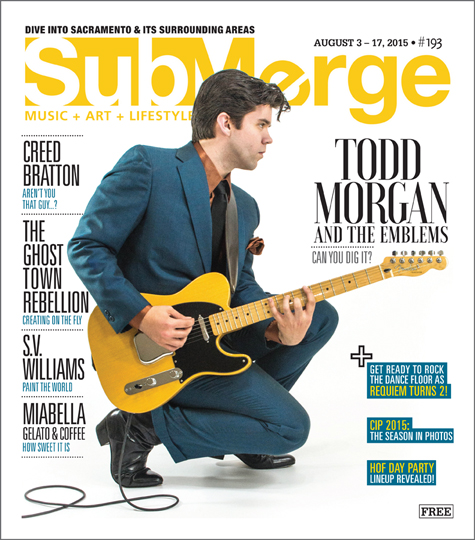
A Sip of Nostalgia
The new Coin-Op Game Room may have a bouncer at the top of the stairs, but this is not a typical posh downtown bar. The wooden staircase winds down into a patio, where people are sipping drinks and playing a giant version of Jenga. Inside, the space strikes a nice balance between a trendy dive bar and a friendly neighborhood pub, with neon beer signs, slices of pizza served on brightly colored Frisbee plates and beer lists printed on chalkboards decorated with pictures of Mario and Luigi. A few people are gathered around the actual bar, but everyone else is clustered around the various arcade games that line the walls—about 40 in all. After Burner, Spy Hunter, Pac-Man, Donkey Kong, an entire row of pinball machines—this barcade is sure to stir up some feelings of nostalgia.
Originating in San Diego, Coin-Op Game Room offers adults a place to play the games they loved while they were growing up while enjoying a craft cocktail or microbrew. According to Evan Louis, one of the managing partners: “We like to explain it as a place that you can play nostalgic video games, get your Pac-Man on, or your Dig Dug or your Street Fighter on, and get a proper Old Fashioned.”

Coin-Op Game Room is a joint operation between Louis and partners Hassan Mahmood and Roy Ledo, owners of the original San Diego location. They also own Lion’s Share, a San Diego bar and restaurant that specializes in craft cocktails and exotic game meat like antelope, wild boar and kangaroo.
When they decided to expand to a third establishment, the original plan was to open another Coin-Op Game Room in Chico. Mahmood and Ledo stopped in Sacramento on their way up to Chico. They explored the downtown area and ended up liking what they saw, especially with the prospect of the new Kings arena on the horizon and all the development that has been happening in Sacramento over the past few years.
“We think in the next five to 10 years Sacramento is really going to move,” Louis says. So they made an executive decision and chose Sacramento over Chico, and settled on the building that used to be Marilyn’s on K. Evan feels they made the right choice in opting to set up shop in the capitol.
“Chico is a college town and nobody wants to pay $6 for a beer. The video games would definitely attract, but you’d have to have some really low prices,” he says.
The Sacramento Coin-Op Game Room is double the size of the San Diego location, but the concept is identical.
“We definitely expanded on that location but it has the same vibe. Craft beers, craft cocktails,” Louis says.
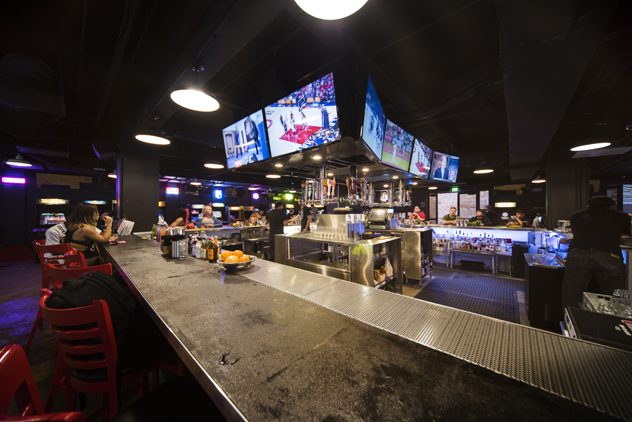
The location ended up being pretty ideal because K Street will become the gateway to the new arena. In San Diego, Lion’s Share is near Petco Park, the baseball stadium, which has been a big draw for getting customers. Louis hopes that the downtown area will soon be picking up.
“Midtown is a little bit more happening, but we definitely think that we can draw some of that midtown crowd to the downtown area and make downtown what it used to be, a little more fun and hip,” Louis says.
Coin-Op Game Room has the potential to draw in a more fun and lively crowd to downtown Sacramento. The bar will host regular tournaments and competitions for the more popular arcade games, such as pinball and Street Fighter.
“There’s actually a huge following of pinball. There are pinball associations across the United States, and we’re already on their radar,” Louis says.
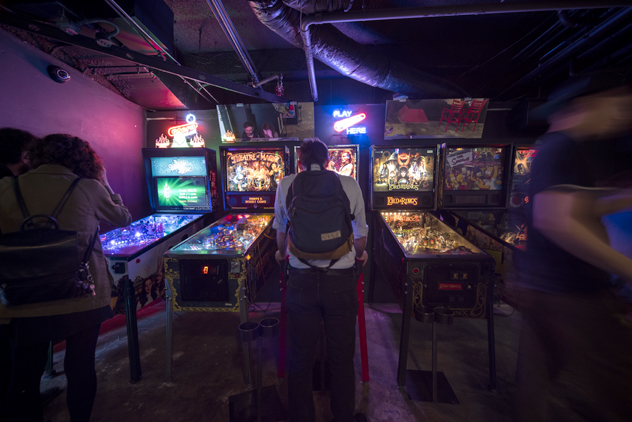
They’re also looking to work with one of the liquor companies, possibly Jack Daniel’s, to do a special Big Buck Hunter competition, offering monthly or bi-monthly specials. The person who gets the highest score over a certain period would get to fly out to Tennessee for a tour of the Jack Daniel’s distillery. And keeping with a San Diego tradition, the last Sunday of every month is free play, and all the games are free. “It’s a really good day for us in San Diego and also a way to give back,” Louis says.
They’ll also have DJs on Friday and Saturday nights. “There’s not too much room to dance but at least you can have some cool ambiance and vibes,” Louis says. They’ve partnered with local DJ Shaun Slaughter, who will be at their grand opening on May 28, and hope to have more local DJs on a regular basis.
The food at Coin-Op Game Room is perfectly suited to the casual, nostalgic feeling the arcade games impart. You can get a slice of cheese, veggie or pepperoni pizza if you just need a quick bite while wrapped up in playing Street Fighter. If you come with a group, you can order a whole pizza pie for a greater variety of toppings, like pesto, prosciutto or the “carnivore.” They also serve appetizers, including typical bar food like hot wings, or more unusual options like meatballs or an olive plate. Food is served until 1 a.m., and unlike many of the bars in the area, the bar stays open until 2 a.m., every night of the week. Louis says he has really enjoyed the crowds they’ve had on the weeknights since they’ve been open. “Sunday was a good crowd. We got a lot of industry people, and that’s like what we get in San Diego,” he says. “We like to cater to the late-nighters.”
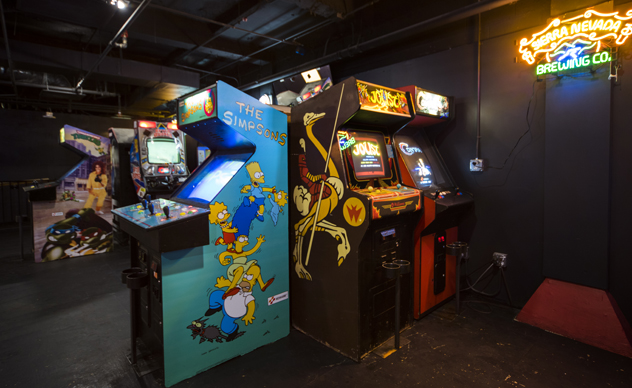
The beer menu is impressive—18 beers on tap, with a range of styles and breweries—varying in strength from session ales to a triple IPA, coffee stout, hard cider and even a sour. Some of the breweries featured at the moment include Alpine Beer Company, Green Flash, Deschutes, Dogfish Head, Track 7 and Knee Deep Brewing.
Their cocktail menu features creative concoctions priced between $7.50 and $9.50, and the names are as intriguing as the ingredients: the “91 Unleaded,” which contains rum, Temple cold brew coffee, cinnamon and black walnut bitters; or the “Tangerine Speedo,” rye, tangerine, tarragon, lemon and ginger beer. For something a little more classic, try the “Leggy Blonde,” a refreshing blend of vodka, pressed ginger and lime, cucumber and mint. For a group, Coin-Op Game Room also has punch bowls, which serve eight.
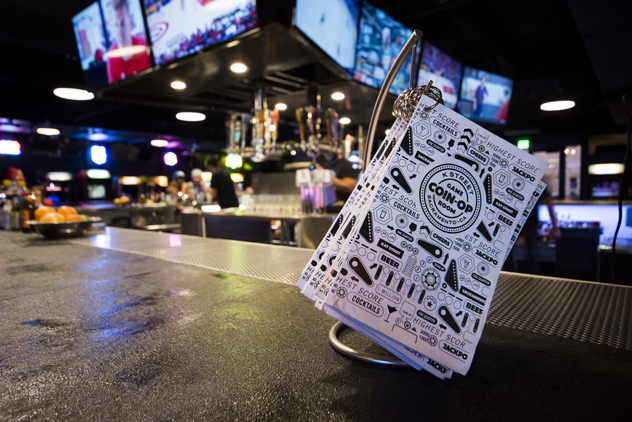
“It’s nice and communal and that’s something we definitely strive for here,” Louis says. But punch bowls are not meant to be enjoyed alone—in fact, the establishment won’t sell them to groups of less than three people. “We don’t want anyone getting sauced up carrying around a punch bowl by themselves,” he adds.
Despite the complicated cocktails and an overwhelming selection of draft beers, Coin-Op Game Room doesn’t have an exclusive or pretentious vibe. “This is a place where you can come by yourself, or with a group of friends, or come to make friends. You never know who you’re going to play Street Fighter next to. Next thing you know you’re having a beer at the bar together,” Louis says. “You can be in a comfortable environment and still get delicious drinks.”
Travis, the bar manager, chimes in: “We’re bringing the cocktail to the people.”
New Found Glory’s New Album Explores Hardships, Triumph and More Songs About Girls
Pop punk isn’t dead. It’s just evolved, much like the bands themselves. New Found Glory’s new album, Resurrection, hits the mark between nostalgia and maturity, reminding fans why they started listening all those years ago.
Established in 1997 out of Coral Springs, Florida, New Found Glory (Jordan Pundik, vocals; Chad Gilbert, guitar; Ian Grushka, bass; and Cyrus Bolooki, drums) came into the scene when pop punk wasn’t quite a “thing” yet. They quickly gained a following and went from just another group of boys with guitars and a knack for storytelling to one of the most influential pop punk bands of that time period. Their teenage years were spent largely on the road, touring with their own musical idols like Blink-182 and Green Day.
Fast forward 17 years later and the guys are now in their 30s, some married, some with kids, still living out the dream of playing the music they love and getting paid to do it. And despite leaving behind their awkward teenage years long ago, New Found Glory still draws fans that are no older than they were when they got their start.
The band found a sweet spot in the pop punk scene with their emotionally charged, fast-paced sound that blends heartfelt pop lyrics with harder, more upbeat punk melodies. Younger fans appreciate their straightforward lyrics and relatable songs about the politics of relationships, including losing the girl, not getting the girl, and realizing the girl wasn’t so great after all. The band also sustains their longtime fans who can’t resist the guilty pleasure of a nostalgic ride into the days of teenage heartache and rebelling against…pretty much everything.
Like any resourceful pop punk band, New Found Glory is skilled at turning heartache and loss into the fuel that powers their creative process. Their eighth studio album, released on Oct. 7, 2014 through Hopeless Records, showcases a more mature take on overcoming hardship and coming out stronger in the end. Appropriately titled Resurrection, the album is a response to many of the challenges the band has faced since their last release in 2011, including parting ways with lyricist and guitarist Steve Klein, one of the band’s founding members, and changing record labels.
The album makes a strong start with the single “Selfless,” an anthem that sets the tone for the overarching vibe of this album: we’re not going to let anything get us down. The theme of power and triumph and rising up after hard times is especially strong in the title track: “These troubled times / Awoke my strength / So watch my / Watch my resurrection.”
“One More Round” can only be assumed to refer to the endless scrutiny and criticism bands face, especially online: “You’re a kid from the future, you’re passive and you’re afraid, sound so bold when you’re on paper, crumble when face to face.” As a band with more than 15 years in the spotlight, this likely is their response to the ever-fickle fans and critics.
And what New Found Glory album would be complete without the “songs written about stupid girls” ballads? The last few songs of the album fall thematically into stories about exes and relationships that were doomed to fail. “Degenerate” is a bit of advice to girls who fall for the wrong type of boys, while “Angel” is a dark but honest take on a relationship that ended eight years ago—and now serves as lyrical inspiration: “I guess lashing out makes it easier, something to sing about just makes it easier.”
Lyrically, even the songs about love take a more mature view on relationships, emphasizing sticking it out rather than giving up. From “Vicious Love”: “I could have given up a thousand times. In the past that was so easy.”
The common thread throughout the 13 tracks on this album revolve around coming to terms with adult life and making the best of whatever is thrown at you. Musically, many of these tracks are right on par with much-loved singles from Sticks and Stones and Catalyst, which will certainly be appreciated by fans from their early days.
Submerge got in touch with singer Jordan Pundik just before New Found Glory’s upcoming Sacramento show at Ace of Spades to hear a little more about the new album and how they’ve grown and matured over the years.
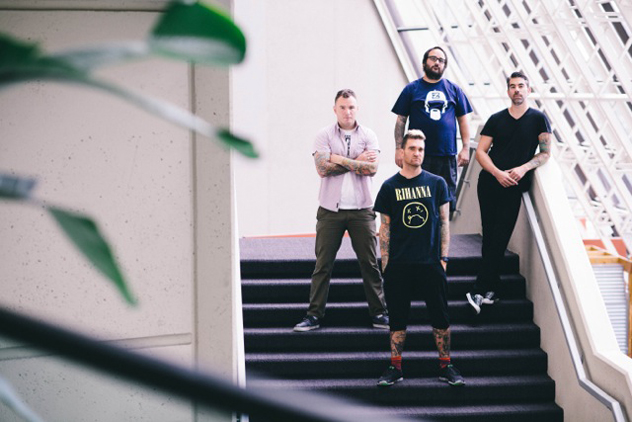
{Photo by Andy Foster}
The new album has definitely matured lyrically but overall it sounds very characteristic of New Found Glory. How has your music changed as you gained more life experiences and stories and what have you tried to keep the same?
I think we’re definitely more self aware, being older. When you’re young and on tour and on the road it’s like a fantasy world at times. Now that we’re older, a couple of us have kids, are married, or divorced and remarried. But we’ve always been a band to write about life experience, the human experience, and that’s where it stands now.
What kind of themes are you exploring that you haven’t really touched on before?
There’s a couple of relationship songs—we’ve always been a band to write about that—but it’s not like, oh I love this person, we broke up. It’s more like, we’ve been together for a while and we’ve been through some really rough shit and we make it through—or we don’t.
And then there are the other songs on the record about dealing with things that are sort of shitty in your life that knock you down, and it’s more about coming out of those things and becoming stronger from it.
Your fans are still a younger demographic. How are you getting younger fans to connect with the music?
I think it’s definitely writing about real things. I think people can connect with that. We’re not trying to hold ourselves higher than anybody else. And I think it has to do with the bands we take on tour and with our live shows—we don’t just stand around. We have a lot of energy.
You came into the scene when pop punk wasn’t so big. What trends have you noticed and how have things changed over the years?
I think it’s more the styles that bands are playing. Take The Wonder Years, for example. They’re a little bit not very polished and their lyrics are very heart-on-your-sleeve, and they’re more storytelling, and they are considered a love pop punk band in our scene.
Then you have bands like Wavves, and they’re super fuzzed out, write two-minute fun pop punk songs and people credit them as these indie masters, like at Coachella, but really at their core they’re a pop punk band. So I feel like there are different styles but it’s all kind of rooted in the same thing.
How have the crowds and your own fan base changed over the years?
There’s still always that dude in the back that started listening to us in ‘99 or 2000, the guys and girls that are hanging out in the back, singing along, but then in the front and in the pit you have a lot of young kids. And for some people that are just now getting into us, I think it’s really cool and says a lot to me that we’re still relevant.
Which songs do you still like to play from your earlier days?
I love playing more fast songs like “Understatement” and “All Downhill from Here.”
Are there any songs you really wish people would stop requesting?
“It Never Snows in Florida.”
What was it like being a teenager and seeing everything grow so quickly, gaining popularity doing what you loved?
That was before any of us were in relationships or had any big responsibilities, so we would be on tour 10 months out of the year. It’s crazy that most of my adult years were spent on tour. I only went to college for a semester, so I did a lot of my growing up on the road.
Did you guys get to do the normal high school type, teenage experiences?
I think we got to do it but on tour. Underage drinking, lighting shit on fire, blowing up port-a-potties…
So now that some of you have children, how has that changed your music or just the band dynamic?
Dynamically, we can kind of relate when we’re on tour together and gone for a few months. Not being able to see them is always hard and we have each other to talk to about that.
But even as far as just being in the band, now there’s a lot more at stake. As far as being able to sustain a life for them, this is what I do. It’s still as fun as ever, being on tour, recording records and meeting fans, and doing what we’ve always done, but it’s always in the back of my mind that there’s more at stake here.
So when do the kids get to start coming to shows and getting in the mosh pit?
My kids have been to the shows. They sit on the side of the stage and watch me.
Wow, they’re getting an early start.
They’re into it for a couple songs but then they want to get off the stage.
I imagine it’s harder now to find time to write and record as a group. What is the creative process like for writing the lyrics and creating the songs?
Especially with the new one, I was going up to Chad’s place—I live in San Diego and he lives in Los Angeles—at least once a week and writing with him in his kitchen. Once we finally had demos of songs that’s when we knew we were going to be recording and get everyone together.
That sounds much more collaborative than some bands I’ve talked to. Has it always been that way?
It’s always been a collaborative process. Obviously a song has to start somewhere, so someone will have a riff idea, or a melody idea, but then we get together and work it out.
Dad’s LPs Experiment with Sound on New Album
Given five words to describe Dad’s LPs, lead vocalist John Morales doesn’t hesitate before responding: “Not the same old thing.” Morales is wise to steer away from concrete musical genres, because Dad’s LPs defies simple descriptors like “alternative rock” or “pop rock.” Their sound spans from airy and upbeat pop to multi-vocalist harmonies to angst-y, grunge-like ballads, with a little something for everyone.
The band started in 2011 as a side project between John Morales (lead vocals and drums) and Jay Seals (guitar and harmony vocals). The duo quickly realized that this partnership was evolving into something bigger and more meaningful than a side project. They teamed up with Chris Twomey (lead vocals, guitar, bass) and Andrew Harris (lead guitar) and settled on the name Dad’s LPs, dreamed up by Morales.
“I had the name Dad’s LPs floating around in the back of my head because that’s where I discovered music—in my parents’ album collection,” Morales explains. The band discovered a common thread in their histories with their dads. Morales’ father had passed away when he was 21, Chris’s dad had passed away several years ago, and Seals’ dad was going through cancer at the time they started writing music together. “We all connected around the idea of giving a nod to the influence that our dads had on our musical growth.”
Dad’s LPs released their self-titled debut album in October 2011 and played their first-ever live show at Placerville’s Hangtown Halloween ball. It was a memorable event, despite the challenging acoustics. “We were in this hangar and it was a giant echo chamber,” Morales remembers.
Since their debut, Dad’s LPs has played shows throughout Northern California, gaining a steady following as their sound evolved and matured. Coordinating times to play together has always been a challenge, as the band members are spread throughout the state—from South Lake Tahoe to Long Beach. “It takes some real logistics planning, which is why we don’t get to play very often. When we do, we want to make the most of it,” Morales says. “We work on the songs independently and bring it all together the weekend before the gig.”
Another challenge has always been that the band packs each song full of so many vocal and instrumental layers that it’s virtually impossible to replicate the sound during live performances with just four band members. The songs are more complicated than just the standard guitar, bass and drums, Morales explains. Most songs also include keyboard, additional guitar parts, random percussion and layers of harmonies. Since the beginning, they have constantly explored new ways to recreate their album sound during live performances without having to hold back on the actual album.
“We’ve never wanted to limit ourselves on the album because of what we’d be able to do live,” Morales says. “We always just wanted to make whatever music was in our heads on the album and then we’ll play them as best we can.”
Dad’s LPs took a three-year hiatus between releasing their debut album and their new follow-up album, and listeners will notice the musical growth between the two albums. “We’ve definitely matured,” Morales says. “The sound, while still varied and diverse, has gotten more cohesive. We’re starting to really find our own voice.” The album is called Lemon on Fire and will be released on CD in mid-September. The band has been releasing tracks off the album slowly over the past few months, and the 10-track album version is currently available for digital download. The official CD release will include an additional two bonus tracks that the band just finished producing.
Lemon on Fire flits between slow and soulful ballads and brighter pop-rock anthems. Songs strike a pleasing balance between vocals and instrumentals. The band has a knack for timing, with most songs wrapping up neatly at around four minutes. Lyrically, each track is a self-contained story, often told with humor, and successfully integrates a rhyme scheme that is subtle enough to not sound forced or childish. These are feel-good tunes—even those that speak to heartache. Morales explains that while there is no common thread throughout the album, the songs have common storylines: “love and heartache and money problems…all these universal themes that we touch on.”
The album opens on the track “Run Around,” an airy and upbeat sing-along tune. The playful and clever lyrics tell the story of “just an ordinary guy”:
Power lunch, back to work, before I hit the gym
I do Pilates for an hour but I don’t get slim
Shower off, powder up, have a real quick shave
Throw on my favorite pair of Levi’s and I’m on my way
The dual vocals in this song have a patchwork effect, and the layered harmonies create a blended sound that would be great to crank up while cruising the freeway.
The tone alters dramatically on the second track, “Ain’t Over Yet,” which boasts a faster pace and a more powerful and in-your-face rock sound. This short track has an addictive build-up:
I can feel the embers burning in the earth below my feet
I’m a sinner in your gallows; this floor is bound to drop
And common sense would tell me to stop
This build-up crashes to a satisfying chorus: “But don’t you tell me to stop!”
“Torn Apart,” the third track, is a melodic break-up ballad that speaks on a universal level to anybody who has experienced heartache, without coming across as whiny or juvenile. The slower pace and poignant vocals are characteristic of several of the tracks on this album, including “A Whisper in the Background,” which showcases the band’s powerful vocals and harmonizing.
“Turn on a Dime” explores a particular indie folk/Americana sound that sets the perfect backdrop for the song’s message of hope and promise.
‘Cause one of these days you’re gonna pull out of the rut
You’re gonna be fine, just fine, just fine
And you and me, babe, we’re gonna live after the cut
Because love can turn on a dime
Other noteworthy sounds you’ll find in this album include the powerful ‘90s grunge sound of the track “Blown Away” and the ska sound of “SOHO.” The album closes on “Cut and Run,” which has a slower pace and a country-like twang that builds up to a triumphant finish.
On the whole, this is an album that embraces inconsistency and isn’t afraid to pay homage to the artists along the years that have made an impact on the band’s musical roots, making it worth a listen.
Dad’s LPs will play at The Torch Club for the first time on Thursday, Sept. 11, 2014. Cover charge is $6 and the show begins at 9:00 p.m. The Lemon on Fire CD will also be released in September, and will include the 10 tracks currently available for digital download as well as two bonus tracks. Check out Facebook.com/DadsLPs for details.
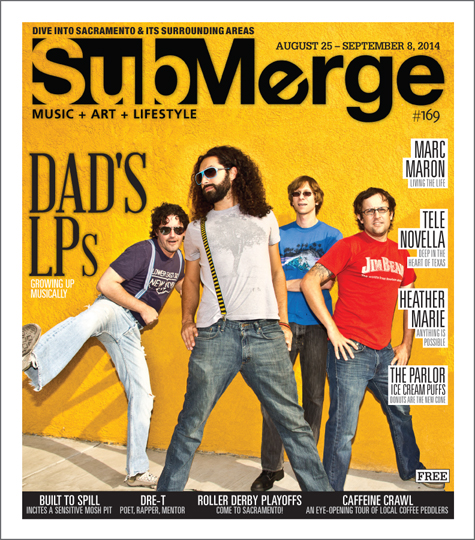
Crawdads on the River
1375 Garden Highway – Sacramento
Crawdads on the River is one of three restaurants in Sacramento that literally floats on the Sacramento River, offering some of the best riverfront views you could ask for. The restaurant is located just off the Garden Highway, in the Riverbank Marina, nestled between a Chevys and some office buildings.
Established in 1986, the restaurant has been native to Sacramento for almost 30 years but is now under new ownership: Trevor Shults, who also owns Pour House and Vanguard 1415, and head chef Adam Pechal of Tuli Bistro and Restaurant Thir13en. Pechal became somewhat of a celebrity in Sacramento after being featured on ABC’s The Taste. The change in ownership resulted in a new menu and some significant remodeling. “Crawdads was pretty before, but we gave her quite the facelift,” says restaurant manager Brett Miller.
Sunday brunch at Crawdads was busy when I arrived just before noon, but it was an older crowd and the atmosphere was mellow. Tables were set up for couples, rather than groups of rowdy 20-somethings like many of the popular brunch spots in downtown or Midtown Sacramento. There was enough shade to make it bearable to sit outside despite the mid-July heat, and the sounds of chirping birds, the river and calypso music made it easy to forget that I was just minutes from the highway.
My server was pleasant and attentive, accommodating my request to switch to the other side of the restaurant for a better view and remembering that I had asked for lemon water with no ice. My meal arrived incredibly fast for a brunch spot, and the dishes were served piping hot.
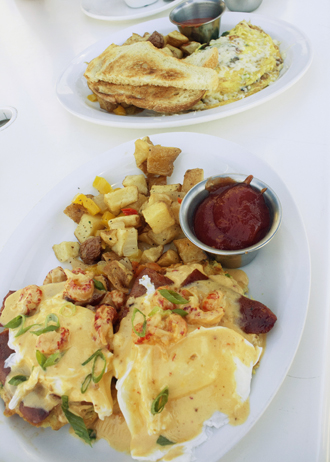
The menu is not huge, but there is a good variety of choices. I started with a healthier option—the Farmers Market Omelet, with spinach, mushrooms, roasted red peppers and aged goat cheese. Finding a decent vegetable dish at a restaurant that serves Southern food is usually a challenge, but this omelet was fresh and light, and the goat cheese complemented the vegetables well. The potatoes were fragrant and cooked to that perfect midway point between crispy and soggy.
Next, no brunch spot is complete without a signature benedict, and Crawdads does not disappoint in this area. The Cajun Benedict is served on a jalapeno-cheddar biscuit with Andouille sausage, eggs and the special “Crawfish Hollandaise.” This dish was surprisingly not too spicy, so it didn’t quite live up to its name, but it was easily my favorite dish. It was also the most expensive item on the menu at $18.

I happen to believe that dessert should be included with every meal, so the Crème Brulee French Toast was my final choice. Picture soft, creamy custard on the inside with that same characteristic burnt sugar crunch on the outside. It’s served with pomegranate syrup, but I don’t recommend using much—this dish is already a little on the sweet side and best shared between two people.
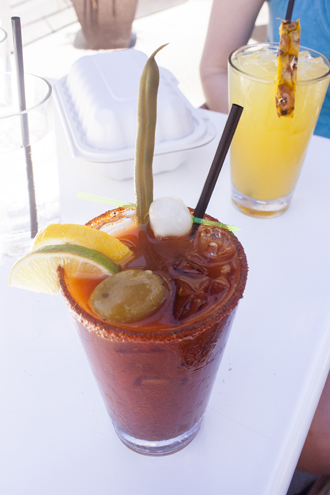
Finally, the cocktails. The selection was a bit overwhelming, although most would be better suited for a happy hour than brunch. As it was still before noon, I went with the “Crispy Mosa,” a refreshing twist on the traditional mimosa that pairs Crispin Cider with orange juice. This is a great option if you’re tired of champagne. I also tried the Cajun Bloody Mary, but abandoned my drink after a few sips because it was just too spicy.
Crawdads might not be my all-time favorite brunch spot in Sacramento, but the quality of the food combined with the riverfront view and relaxing ambiance certainly will make me a return customer.
Crawdads is located at 1375 Garden Highway in Sacramento and is open Sunday–Thursday from 11 a.m.–12 a.m. and Friday–Saturday from 11 a.m.–2 a.m. Visit Saccrawdads.com for more info.
Punk Rock Vixen Turned Full-Time Mom Brody Dalle Blossoms With Spinnerette
Don’t grieve over the loss of badass punk rock singer and guitarist Brody Dalle of The Distillers quite yet—Dalle’s new band, Spinnerette, offers more ear candy for your listening pleasure.
Named after a spider’s silk-spinning organ, Spinnerette is more than just a revamped version of The Distillers—the band attempts to branch out and conquer new musical territory. “Spinnerette is more musical, more like the sound of music,” Dalle says. The Distillers were, in Dalle’s words, more of “a dirty punk-rock band.”
The Distillers released their final album, Coral Fang, in 2003. The band came to a natural end just a couple years later. “Creatively we had hit a wall and we were exhausted,” says Dalle. “We had been on tour for two years straight and we were a raw nerve”¦ It was a really unhealthy time, and we all imploded.” At first, she remembers the breakup being pretty messy, but alliances have been restored; Spinnerette features former guitarist for The Distillers Tony Bevilacqua. The band also consists of bassist Alain Johannes (Eleven, Queens of the Stone Age) and drummer Jack Irons (Red Hot Chili Peppers, Eleven).
Spinnerette was officially formed “on a blue moon” in mid-2006, says Dalle. She and hubby Josh Homme from Queens of the Stone Age had just experienced the arrival of their first child, Camille, and Dalle was aching for music. “I hadn’t done music for so long at that point, and my life had changed so much. I was desperate to have a little glimpse of myself.”
If a new maturity can be heard in Dalle’s music, it’s likely that her daughter is part of the reason. The transition from full-time musician to mother was difficult. “It was probably the hardest transformation of all time,” she says. Camille is now 3 years old, and is apparently not fazed by having rock stars for parents. “She just thinks that everyone’s mom does this for a living,” Dalle laughs.
Overall, the chemistry between the band members has been amazing. “I started writing with Alain after Camille was born and it kind of just organically happened, and became this thing magically overnight,” Dalle says. “It was like I planted a magic bean and it sprouted.”
The band’s releases trickled out slowly, starting with the song “Valium Knights” in 2008. They’ve also released several singles, a Ghetto Love EP and a 12-inch vinyl. “We’re slowly feeding everybody new things,” Dalle says.
Their debut album is self-titled, and was released in June 2009 after many difficulties. “Everything you could throw at someone, we had thrown at us,” Dalle remembers. They were originally going to release their album through Sire Records last February, but had some issues going through a major record label. In the end, they went with Rush’s label, Anthem Records, which Dalle feels was a fitting choice. “[Rush] started a label because nobody else would sign them, so it seemed so appropriate for us to sign
with them.”
Die-hard fans of The Distillers are divided in their opinions of Spinnerette. “Some of them like it and some of them hate it,” Dalle says. “It’s kind of to be expected.” To be fair, fans of The Distillers may be disappointed if they’re expecting to hear the same rebellious punk gal screaming with post-adolescent angst. Spinnerette’s songs are catchier and more melodic, hinting toward a newfound musical maturity.
But Spinnerette’s music certainly won’t be too mild for your taste buds—the songs go down smoothly but leave a bitter taste at the back of the throat.
Dalle writes all the lyrics herself, and she describes the album’s theme as “relationships and transformation, and coming out unscathed.” She writes with the same in-your-face attitude you would expect from former frontwoman of The Distillers, such as in the song “Rebellious Palpitations,” where she writes: “Hey what’s your name?/I’ll take everything you’ve got/All aboard the drunk express/Bottles of wine in excess.“ Dalle wails in her characteristic raspy voice about sex, love, pills, sex, a bit of wine and that oh-so-heartless cupid. Oh, and don’t forget about sex. Surely Dalle is no tempered flame.
While Spinnerette’s studio releases feature the same core group of musicians, Dalle takes a different approach to live shows, recruiting talent from amongst her vast group of musical friends and acquaintances. “We don’t have to be so serious about being a band anymore,” Dalle says. “It seems so silly to sign your life away and put your heart on the line. We’re just going to go out and play shows.” Musicians who have played with her include Vincent Hidalgo, Bryan Tulao, Dave Hidalgo Jr. (Suicidal Tendencies), Nicole Fiorentino (Radio Vago) and Matt Caughthran (The Bronx).
Spinnerette previously toured with Band of Skulls, and are now embarking on several solo shows, as well as the 2009 Capitol Hill Block Party in Seattle and the Virgin Festival in Vancouver, BC. Spinnerette will be playing at the Boardwalk in Orangevale on July 22, 2009.
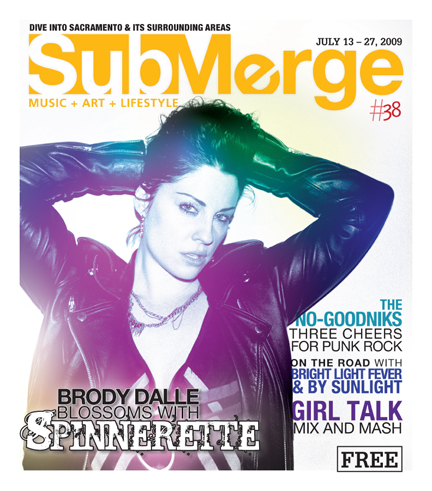
Oakland artist Jesse Hazelip’s mixed-media artwork has captivated viewers throughout the Bay Area and beyond, in locations such as Los Angeles’s Thinkspace and Abacot Gallery and The Space in Chico, Calif., to name a few. The political commentary in Hazelip’s art is not subtle. Many of his pieces illustrate the stark contrast between the destructive nature of mankind and the peaceful beauty of the natural world. The results are unsettling: A buffalo’s body attached to the nose of a fighter plane, or a heron’s body with the head of a deadly weapon, flying across a geometric sky.
Hazelip’s art is evocative of a wall covered in colorful graffiti—pointing to his origins as a graffiti artist. “I used to be really deep into graffiti, and I would always try to paint something different each time I went out,” he explains. As you can probably imagine, this got him into some trouble during school. The rebellious teenager inside of him might be tamer now, but certainly isn’t absent. “I am currently trying to refine my aesthetic into a cohesive body of work, and create a visual language of my own,” he says.
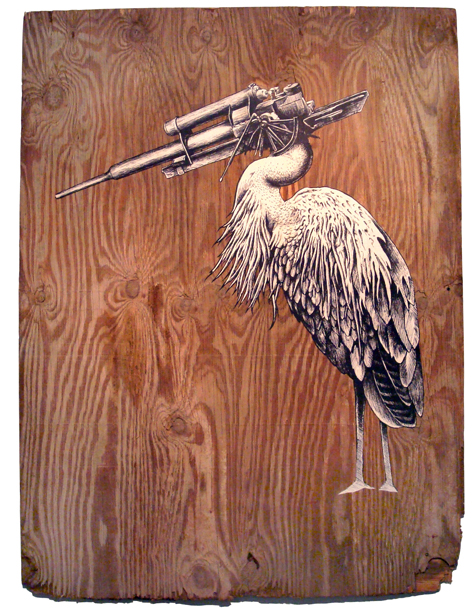
True to his roots as a graffiti artist, Hazelip prefers to show his work where it can attract the most attention. “My favorite place to display my work is on the street, in public domain, in hopes of creating dialog amongst the Proles,” he says. For example, this past February one of his creations could be found on the wall of a building in the Mission District of San Francisco.
While these graffiti-like pieces give the illusion of spontaneity, in actuality he has put considerable effort into every finished piece. “I collect reference and read about potential paths I want to explore. I do tons of small rough drafts, and sometimes large fully rendered drafts,” Hazelip explains. “But the drawing is always the most time consuming aspect of any of my work.”
Considering that most pieces are literally larger than life, the finished products are impressive. “Scale is very important to me, and the gravity of larger pieces has always resounded with me. I like to make things life-size or larger, something you have to stand back from to fully appreciate, but also draws you in to inspect the detail,” he says.
These large-scale pieces are fitting for his subject matter. His themes generally include social issues that he feels need to be addressed, such as war. He uses a variety of mediums to get his message across, and is currently working with everything from drawing and painting to print and mixed media. “I love drawing with practically anything that makes a mark, and the same with painting,” he says.
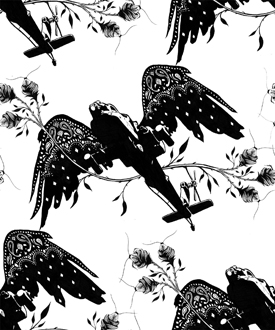
Hazelip received his BFA from Art Center College of Design, and for now, he pays the bills as a commercial illustrator. Someday, he hopes that he can devote himself completely to his own artwork, stating that his goal is “making my art for a living, not having to answer to an art director, having complete artistic freedom.” He is optimistic that although art may not be the easiest career path, it’s the right path for him. “Art is a rough trade, especially in today’s economy, but that’s part of the struggle,” he says. “It’s really hard work, and artists get exploited a lot, but it’s all a learning experience.”
Hazelip’s most recent collection is entitled Tempest Turner, and is aptly named after a WWII bomber plane. In these pieces, Hazelip continues to explore the dark contrast between mankind and the natural world, questioning whether man will ever learn from the mistakes of the past. This collection will include a variety of mediums, such as silkscreen prints, acrylic on wood, ink on paper and mixed media on found wood.
His hopes for his art are far-reaching, and he says he has several dream galleries in large cities like San Francisco, Los Angeles and New York where he would love to show his work—as well as taking the creativity with him and traveling overseas. But no matter how famous he becomes, he retains the humble goal of using art as a communication vessel: “I feel that I have a responsibility as an artist to voice concern with my craft, to seize any platform I can and use it for a greater good.”
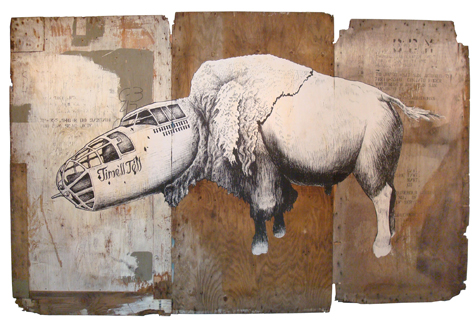
Going to Second Saturday? Jesse Hazelip’s new collection, Tempest Turner, will be shown at Space07, located at 1421 R. Street, Sacramento. The collection will be shown from June 13 through Aug. 9. You can also check out his work online: www.jessehazelip.com and jessehazelip.blogspot.com.
Autumn Sky Charms Fans With Her Upcoming Album
Whether crooning about a budding romance or a broken heart, Autumn Sky’s sparkling melodies resonate long after the final notes die down. Like an intimate conversation, Sky’s confessional narratives are blended with twinkling instrumentals. Her music leaves you with a warm feeling—like reading a book on a rainy day. Most of her songs sparkle with hopefulness and celebration, but there is also the occasional haunting gray lullaby.
Surprisingly, this precocious singer/songwriter is just 20 years old. “I do things early. I don’t really wait around for everyone else,” Sky explains. “I’m not going to be one of those people who sits back and regrets wasting my life on drinking and partying in college.” But, she is looking forward to turning 21 in October—most of the venues she plays are 21-and-over, which means she has to leave the building the second she finishes her set.
Music was something Sky fell into naturally. She already had the name—her first name is actually Autumn, and Sky is her middle name—and she was born into a musical family. “My family is very big and my mom is very musical and she always had us learning instruments or singing,” Sky says. “We were just constantly surrounded by it.”
Being part of a musical family meant early exposure to various instruments, such as the piano at age 6 and the violin at age 12. She had a guitar as a teenager, but admits that it just sat around in her room because she wasn’t motivated enough to learn how to play. “I wanted to go do cool things, and learn the guitar was not one of them. Until it got cool to play guitar, it just sat in my room and looked pretty, like a prop.” Then came the deciding factor: boys. “I went to summer camp and all the cute boys played guitar,” she laughs. “There was a talent show and I was like, I’d better learn a song or something.”
Being home-schooled and graduating at age 17 left Sky with lots of time to spend on herself and figuring out what she wanted to do. “I ended up getting into the scene pretty early on because I had extra time and there wasn’t anything else to do. I had my driver’s license and I had a guitar,” she says.
Like other budding musicians in the Sacramento area, Sky started out playing at local coffee shops and open mic nights and worked her way up to paying gigs. She used to play as many as five nights a week, until someone told her, “slow down, you’re going to kill yourself. You’re not even 20 yet.” Now, she’s discovered that by playing less shows per month in the Sacramento area, she gets a better turnout and a better crowd with much more energy. It also allows her more time for touring and playing in other cities.
Attend one of Sky’s shows and expect a diverse mix of instruments and sounds. Many call her eclectic, to which she modestly responds, “I think I just don’t make up my mind.”
Her shows generally include two to three instruments—usually the guitar, the ukulele and the autoharp. Also in her musical repertoire are piano, organ, tambourine, drums, flute, recorder, accordion and classical violin.
Her sets differ from night to night. “Depending on what the mood is in the set, I’ll be like, ‘well we could use something light and airy.’ So we’ll throw in a ukulele song.” This gives her a lot of control and flexibility, and also ensures that she doesn’t get tired of her sets.
Even though Sky uses a wide array of instruments and writes songs in many different styles, she still strives to create a signature sound. While she is constantly experimenting with the songs she writes at home, these may not make it into her sets. Like some of her favorite musicians—think Regina Spektor and M. Ward—her “sound” has a simple and folk-like appeal. “I really appreciate just plain old stripped-down acoustic songs,” she says. “I really love careful finger-picking and light, jingly sounds accompanying.”
An avid reader, Sky places a lot of emphasis on her lyrics, which are often narratives. “The music I tend to write always tends to be slightly upbeat and happier, hopeful or celebratory. Or at the very least, with a message of goodwill at the end of a very sad song.” Above all, she writes about love in its many forms.
Sky’s EP, Diminutive Petite, was released this past November. The title refers to a line from the Madeline theme song: “She may be teeny-tiny, diminutive petite, but that has never stopped her from being pretty neat.” Her full-length album comes out on April 24, 2009 and is called All Which Isn’t Singing. The title is from the ee cummings poem, “all which isn’t singing is mere talking.”
Someday, she thinks it would be nice to be backed by a band, but for now she is content working as a solo act. “Until you get signed it’s really not practical to go out and hire all these musicians. Unless I’m making enough money to give it back to the musicians, it’s not really worth their while.”
School is still on the back burner, and includes plans to study child development and music therapy. Her little brothers are autistic, and she wants to specialize in autism. But at the moment, music is her main focus. In her optimistic way, she says simply, “I’ve been really blessed lately.”
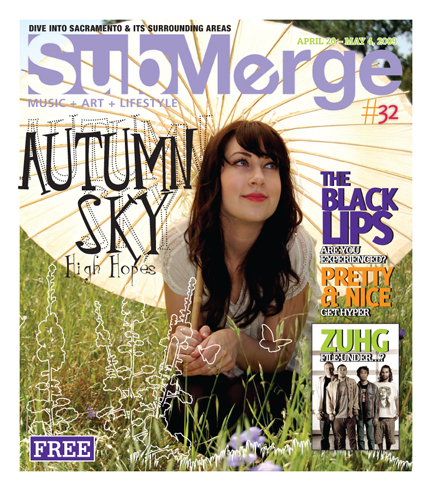
Relentless About the Music
Forget about your one-hit wonders and starry-eyed kids just breaking into the music scene. Despite a lack of local publicity, Another Damn Disappointment has been a staple of the Sacramento music scene for a good 10 years and has a lot to show for it.
“We’ve done rad shit,” says singer and songwriter Josh Thompson. “Our shit was on MTV’s The Real World, in the background. I’ve been driving through other states and heard our stuff on the radio. But in Sacramento, we’ve had zero recognition.”
This lack of love from their hometown is partially responsible for their name, Another Damn Disappointment, a name which was chosen midway through the band’s career. In the early years, the band was known simply as ADD, an apt name considering two of the members of the band actually had Attention Deficit Disorder, and that their musical style was “punk-rock fast,” as bass player Casey Marsullo says.
The name Another Damn Disappointment was added later, when a record label prodded them for a more distinctive name. Considering the band’s dissatisfaction with the Sacramento music scene, this name is equally appropriate. “We have a great fan base here and a big following, but no one really sticks [up] for us. We’re on the radio all the time and KWOD has always been really nice to us, but as far as anything else goes, this city I don’t think supports its bands,” Thompson explains.
But ADD didn’t let this get them down. They started playing in Los Angeles, and found the crowd to be much more receptive to punk rock music. They’ve played all across the United States and Canada, including two summers of playing on Vans Warped Tour, a CD release show with Pennywise on Catalina Island and a show at House of Blues, Anaheim. “We’ve toured our asses off: Vancouver, Seattle, Portland, New York, Kansas, Florida, pretty much every major city you can think of,” says Marsullo.
In Sacramento, their hearts still go out to The Boardwalk, which is where they played their first show. “The first year we played there almost once a month and just packed it in,” Marsullo says. “That’s how we built up a reputation with promoters. [They were] like, God, ADD packs it in there! Where did this band come from?”
In the beginning, ADD was just a bunch of punk kids who wanted to be part of the music scene. “After years of going to punk rock shows and getting beat up in the mosh pit, one day I was thinking that it would be kind of cool to be the guy onstage looking down on that instead of the guy in it,” Marsullo remembers. They got together with some buddies at Folsom High, including current guitarist Ross Standley, and started playing, and it was crap. Thompson says, “We were so into punk and living that lifestyle for so long that it didn’t even matter that we sucked. We had the desire to play punk music so much that it was overwhelming everything else.”
Marsullo adds, “We just kept rocking.”
Luckily, the talent came with time. And just as the music grew and changed, so did the band members. In 2007, they added a second guitarist, Aaron Welch, who had been a fan of the band for quite a while. Thompson remembers that when Welch came to try out for the part of rhythm guitarist, he blew them away with his talent, he knew all of the songs, even the solos. It turned out that Welch had a degree in music, knew how to record and even listened to all of the same music. “It was a perfect fit,” Thomspon says.
ADD has been through their share of drummers before current drummer Carl Chang joined a couple of months ago, and every drummer has been better than the last. “It’s like the missing piece that needed to be there,” Thompson says about Chang. “[He is] the epitome of a bad-ass drummer.”
Thompson writes all the lyrics, usually while drinking a lot of coffee and taking some Adderall, he says. “Usually I will try to do a couple about society or politics, whatever bullshit is going on,” says Thompson. “And then there’s always the woman in my life that’s fucking me up. I’ll probably write a few about that. Standard punk rock.” And of course, a few songs are dedicated to going out and getting drunk.
Their first album, Quarter Life Crisis, was self-produced and came out in 2000. They describe this album as being “pop-y punk.” Next, they released Hooligan through Volcom Entertainment, which was a little more aggressive and dark than their first. Their new album will be released through Felony Records, and they describe it as being more “metal-punk.” It is called Relentless, which pretty much describes the attitude of the band. Thompson says, “Through all the trials and tribulations, whatever bullshit that has gone down, [we are] relentlessly playing.” The cover art illustrates this idea. Thompson describes it as, “an old fifties style bomber plane being shot and going down in smoke but still firing its guns, not stopping until it’s dead.”
Their sound has changed a lot since the band’s formation, continuing to move away from traditional punk music into a darker and more mature sound. Thompson explains, “The band’s talent level kept on getting better, so the music is just adapting. We can do so many more things now, especially with Aaron being on board with the second guitar.”
Although Relentless hasn’t even been officially released, they are already hard at work on their next album, and have four songs written. Thompson and Marsullo agree that this next album will be, overall, just the next step in their musical talents, heavier and more intricate. “[There are] more interesting things going on rather than your standard four-chord punk rock song,” Thompson says.
Goals for the near future? “I’d like to see this record really take off,” Thompson says. “It’s the first CD that we’ve done that I’m actually really proud of and I’m fully backing.”
